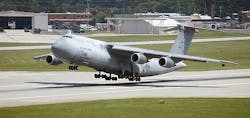Lockheed Martin to install new mission computers and weather radars in Air Force C-5M cargo jets
WRIGHT-PATTERSON AFB, Ohio, 26 March 2014. Military avionics experts at the Lockheed Martin Corp. Aeronautics segment in Marietta, Ga., will upgrade the mission computer and weather radar systems in the giant C-5M Super Galaxy cargo jet under terms of an $84.3 million contract announced late Tuesday.
The avionics upgrade contract calls for Lockheed Martin to begin full-scale development of the C-5 Core Mission Computer/Color Weather Radar, which is part of a long-term program to extend the life of the Air Force C-5 fleet beyond 2040.
By the end of 2017 Air Force leaders expect to have a fleet of 52 C-5M aircraft. Awarding the contract were officials of the Air Force Life Cycle Management Center at Wright-Patterson Air Force Base, Ohio.
The C-5 is larger than a Boeing 747 and is one of the largest military transport aircraft in the world. The aircraft, which has been in the Air Force transport fleet since 1970, is large enough to fit six Greyhound buses, lined up two abreast. The aircraft is designed to perform strategic airlift, emergency aeromedical evacuation, transport of brigade-size forces and equipment, and delivery of oversize cargo.
Related: C-5 Galaxy to receive avionics upgrade
The aircraft can transport 12.5 tons, and can carry two M1 Abrams main battle tanks, an Abrams tank plus two M2 Bradley Fighting Vehicles, 10 Light Armored Vehicles, six AH-64 Apache attack helicopters, or 36 standard cargo pallets. The aircraft's lower deck also can accommodate 270 troops.
The C-5 Core Mission Computer (CMC) and Weather Radar replacements that Lockheed Martin engineers will do is mitigate the obsolescence of the current CMC and weather radar. This effort will replace the current mission computer, as well as replace the weather radar with a commercial off-the-shelf color weather radar.
Since 2002 the C-5M has undergone a major series of upgrades, including the Avionics Modernization Program to install a mission computer, a glass cockpit with digital avionics including autopilot and automatic throttles, and communications, navigation, and surveillance components for air traffic management. The aircraft also has received new engines.
The C-5M also is susceptible to information assurance problems, Air Force officials say, and the new open-systems core mission computers are expected to solve these issues. Upgraded computers are expected to obtain sufficient capability and capacity for future requirements, and offer greater reliability and simplified fleet-wide training.
Related: Lockheed Awarded Avionics Modernization Program
The new distributed-architecture core mission computer will have a 100-megabit-per-second Ethernet interface over copper wire, and will have several sources of supply for components such as MIL-STD-1553 interface chips, single board computers, and I/O cards.
The core mission computers for the C-5 also will have commercial standard video interfaces with VGA as a minimum, at least one additional expansion data bus for federated systems or new line-replaceable units (LRUs) covering Ethernet, MIL-STD-1553, and ARINC 429 avionics databuses.
The computer will separate classified and non-classified data for at least one data bus type for proper isolation of classified information, Air Force officials say. It will support the weather radar, flight management system (FMS), and communication navigation surveillance (CNS) and air traffic management (ATM) subsystems, including automatic dependent surveillance-broadcast (ADS-B) Out, and identification friend or foe (IFF) Mode 5.
The new computers also will be able to accommodate future capability like the Joint Tactical Radio System into the communication system; memory expansion and processing necessary for the Joint Position Approach and Landing System algorithms; and memory and processing power necessary for new data links on the C-5M such as Link 16 or the conceptual Mobility Air Force Data Link.
On the contract awarded Tuesday, Lockheed Martin will do the work in Marietta, Ga., and should be finished by March 2017. For more information contact Lockheed Martin Aeronautics online at www.lockheedmartin.com/us/aeronautics, or the Air Force Life Cycle Management Center at www.wpafb.af.mil/aflcmc.

